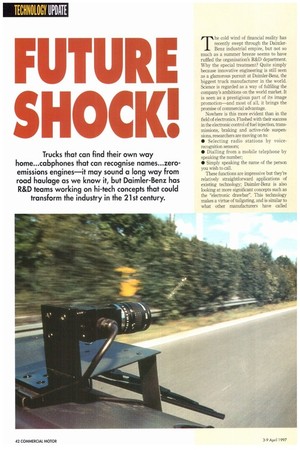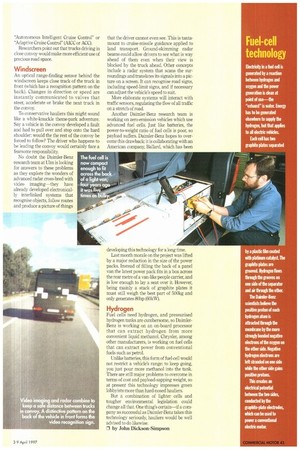i 4 1 'I I I E
Page 44

Page 45

If you've noticed an error in this article please click here to report it so we can fix it.
SHOCK!
The cold wind of financial reality has recently swept through the DaimlerBenz industrial empire, but not so much as a summer breeze seems to have ruffled the organisation's R&D department. Why the special treatment? Quite simply because innovative engineering is still seen as a glamorous pursuit at Daimler-Benz, the biggest truck manufacturer in the world. Science is regarded as a way of fulfiling the company's ambitions on the world market. It is seen as a prestigious part of its image promotion—and most of all, it brings the promise of commercial advantage.
Nowhere is this more evident than in the field of electronics. Flushed with their success in the electronic control of fuel injection, transmissions, braking and active-ride suspensions, researchers are moving on to: • Selecting radio stations by voicerecognition sensors; • Dialling from a mobile telephone by speaking the number; • Simply speaking the name of the person you wish to call.
These functions are impressive but they're relatively straightforward applications of existing technology; Daimler-Benz is also looking at more significant concepts such as the "electronic drawbar". This technology makes a virtue of tailgating, and is similar to what other manufacturers have called "Autonomous Intelligent Cruise Control" or "Adaptive Cruise Control" (AICC or ACC).
Researchers point out that trucks driving in close convoy would make more efficient use of precious road space.
Windscreen
An optical range-finding sensor behind the windscreen keeps close track of the truck in front (which has a recognition pattern on the back). Changes in direction or speed are instantly communicated to valves that steer, accelerate or brake the next truck in the convoy.
To conservative hauliers this might sound like a white-knuckle theme-park adventure. Say a vehicle in the convoy developed a fault and had to pull over and stop onto the hard shoulder: would the the rest of the convoy be forced to follow? The driver who happens to be leading the convoy would certainly face a fearsome responsibility.
No doubt the Daimler-Benz research team at Ulm is looking for answers to these problems as they explore the wonders of advanced radar cross-bred with video imaging—they have already developed electronically interlinked systems that recognise objects, follow routes and produce a picture of things that the driver cannot even see. This is tantamount to cruise-missile guidance applied to land transport. Ground-skimming radar beams could allow drivers to see what is way ahead of them even when their view is blocked by the truck ahead. Other concepts include a radar system that scans the surroundings and translates its signals into a picture on a screen. It can recognise road signs, including speed-limit signs, and if necessary can adjust the vehicle's speed to suit.
More elaborate systems will interact with traffic sensors, regulating the flow of all traffic on a stretch of road.
Another Daimler-Benz research team is working on zero-emission vehicles which use advanced fuel cells. Just like batteries, the power-to-weight ratio of fuel cells is poor, so payload suffers. Daimler-Benz hopes to overcome this drawback: it is collaborating with an American company, Ballard, which has been developing this technology for a long time.
Last month morale on the project was lifted by a major reduction in the size of the power packs. Instead of filling the back of a panel van the latest power pack fits in a box across the rear metre of a van-like people carrier, and is low enough to lay a seat over it. However, being mainly a stack of graphite plates it must still weigh the best part of 500kg and only generates 80hp (60kW).
Hydrogen
Fuel cells need hydrogen, and pressurised hydrogen tanks are cumbersome, so DaimlerBenz is working on an on-board processor that can extract hydrogen from more convenient liquid methanol. Chrysler, among other manufacturers, is working on fuel cells that can extract power from conventional fuels such as petrol.
Unlike batteries, this form of fuel-cell would not restrict a vehicle's range: to keep going, you just pour more methanol into the tank. There are still major problems to overcome in terms of cost and payload-sapping weight, so at present this technology impresses green lobbyists more than hard-nosed hauliers.
But a combination of lighter cells and tougher environmental legislation could change all that. One thing's certain—if a company as successful as Daimler-Benz takes this technology seriously, hauliers would be well advised to do likewise.
CI by John Dickson-Simpson




































































































